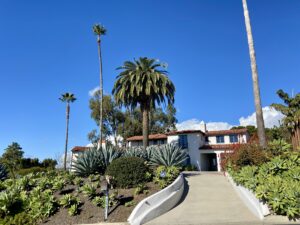By Christine Lampert, Architect, AIA, NCARB

CASA PACIFICA
Before 1920, San Clemente didn’t exist It was grasslands with sweeping ocean views and ranchlands that extended up into the mountains as far as one could see. The three founders envisioned this land as the “Spanish Village by the Sea,” and they were able to purchase 2,000 acres of oceanfront land and create a master plan for the new town of San Clemente. Ole Hanson was one of the three founders, along with Hamilton Cotton and Thomas F. Murphine. Ole Hanson designed the master plan of the city and laid out the curving street designs.

Casa Romantica
They built a community center, horse trails and stables, the community pool, a hotel, parks and the fishing pier. In 1925, the lots were sold for as little as $300 each. Ole’s own office was upstairs in the building at the top of Avenida Del Mar that until recently housed the Baskin-Robbins next door to South of Nick’s restaurant. All structures were required to be “Spanish Colonial Revival style.” There might have been as many as 1,000 Spanish-style buildings built Today, approximately 200 Spanish Colonial Revival buildings remain, and they are referred to as “Ole Hanson

Goldschmidt House
The Great Depression of 1928 brought most projects to a halt and building didn’t start again until after World War II, without the requirement for Spanish design. One of the most prominent remaining Ole Hanson buildings is the Goldschmidt House, which is located at 243 Avenida La Cuesta. Not only was this 1928 home a beautiful example of Spanish Colonial Revival architecture. It was designed by one of the most famous Los Angeles architects of the time, Paul Williams. He was the architect to many wealthy Los Angeles families. The Goldsmidts were part of that LA group,

MURPHINE NOW
as well as being San Clemente local landowners. Today, the house today stands on three-quarters of an acre of land0and is 4,800 square feet The Goldschmidt family were the landowners who had sold the 2,000 acres to Ole Hanson and his partners. They were German Jewish vintners who had purchased the land to grow wine grapes, but the prohibition of alcohol in the United States from 1920 to 1933 stopped them. Another historic Ole Hanson home is La Casa Pacifica, which was built by Hamilton Cotton on the far south end of town. This home was made famous

Ole Hanson Office
in the 1970s when then-President Richard Nixon purchased it as his “Western White House. “Thomas F. Murphine, who was San Clemente’s first mayor, lost his San Clemente house when it fell down the cliff in 1933, three days after the Long Beach earthquake. Though the house was never rebuilt, the old carriage house remains on West Avenida de los Lobos Marinos behind the cliff where the main house once stood. Ole Hansen’s house, called Casa Romantica, is a 7,200-square-foot courtyard home overlooking the San Clemente Pier. It was purchased by the City of San Clemente and restored into a cultural center open to the public for all to enjoy. The home’s detailing is traditional Spanish Colonial Revival.

” Christine Lampert of Lampert Dias Architects is a member of the American Institute of Architects and is certified with the National Council of Architectural Registra Boards. She has lived in San Clemente for more than 45 years, and also resides part time in Hong Kong. Christine Lampert,Architect, A IA, NCAR B “
